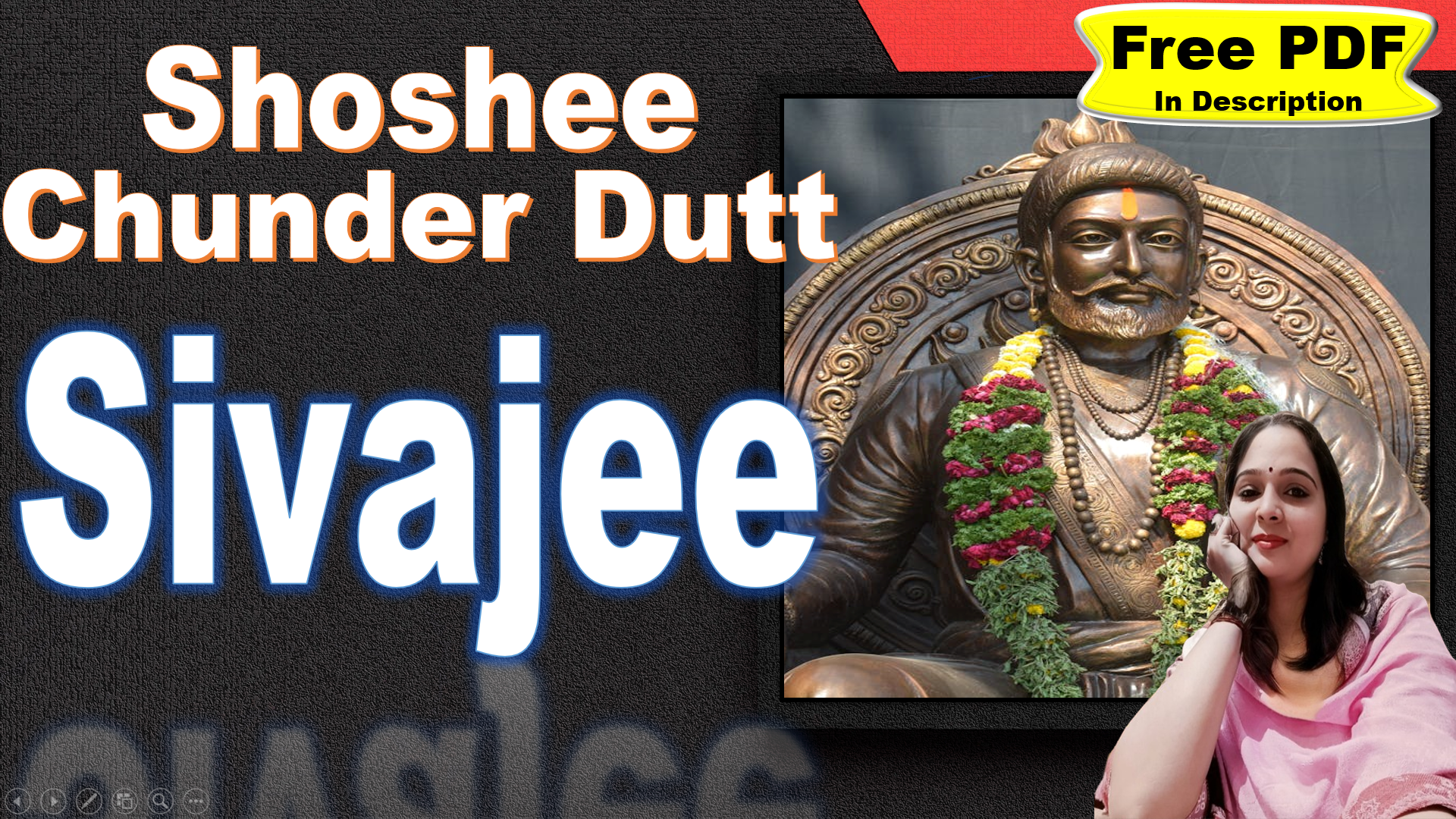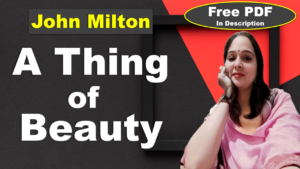Sivajee by Shoshee Chunder Dutt Analysis
Stanza 1
They led him to the stately hall,
Before the royal throne.
Where, towering in the pomp of power.
The tyrant sat alone;
And knights and nobles stood around.
Elate with haughty pride,
And slaves, in gorgeous tinsel dress’d,
Awaited by their side.
Explanation: The first stanza of the poem “Sivajee” by Shoshee Chunder Dutt sets the stage for the narrative. It describes Sivajee being led into a grand hall where Aurangzeb, referred to as the “tyrant”, sits alone on his royal throne. The use of the word “tyrant” suggests that Aurangzeb is a harsh and absolute ruler, setting up a contrast between him and Sivajee.
The phrase “towering in the pomp of power” paints a picture of Aurangzeb’s imposing presence and the grandeur of his rule. This not only establishes his authority but also underscores the intimidating atmosphere of the court.
The stanza further describes the court scene with knights and nobles standing around, filled with “haughty pride”. This indicates their arrogance and sense of superiority, possibly stemming from their association with the powerful emperor.
Finally, the stanza mentions slaves dressed in “gorgeous tinsel”, waiting by the side. This detail adds to the opulence of the scene and highlights the stark social hierarchy in the court. The slaves’ role is to serve and wait, further emphasizing the power dynamics at play.
Overall, this stanza introduces the main characters and the setting, providing a backdrop for the events to unfold. It effectively sets the tone for the tension and conflict that are central to the poem. The vivid imagery and careful word choice help to create a vivid picture in the reader’s mind, drawing them into the narrative.
Poetic devices
Imagery: The poet uses vivid descriptions like “stately hall”, “royal throne”, and “gorgeous tinsel dress’d” to create a mental picture of the grandeur of Aurangzeb’s court. This helps the reader visualize the scene and understand the opulence and power of the court.
Metaphor: The term “tyrant” is a metaphor used to describe Aurangzeb, indicating his oppressive rule. This choice of word conveys the poet’s perspective on Aurangzeb’s rule and sets the tone for the conflict in the poem.
Stanza 2
He knelt before the tyrant’s throne,
But caught no courtly smile ;
The monarch looked with eye of scorn —
Then darkly gazed awhile ;
And minions proud, whose hearts had quail’d
When told his name of fear,
Now mock the valiant Sivajee
With cold respect and sneer.
Explanation: In the second stanza of “Sivajee” by Shoshee Chunder Dutt, Sivajee is shown kneeling before Aurangzeb’s throne, a traditional gesture of respect and submission. However, instead of receiving a warm or welcoming response, Sivajee is met with a scornful look from the emperor. The phrase “caught no courtly smile” suggests that Aurangzeb’s reaction was cold and dismissive, further emphasizing the tension between the two figures.
The line “The monarch looked with eye of scorn — Then darkly gazed awhile” paints a picture of Aurangzeb’s disdain and perhaps even contempt for Sivajee. His dark gaze could also imply a sense of foreboding, hinting at the conflict to come.
The stanza then shifts focus to the courtiers, referred to as “minions proud”. These individuals, who once feared Sivajee, now mock him. The phrase “whose hearts had quail’d When told his name of fear” underscores the reputation and influence Sivajee once held. However, in the safety of the court and under the protection of the emperor, these courtiers now deride Sivajee with “cold respect and sneer”.
This stanza deepens the conflict introduced in the first stanza. It highlights the disrespect and scorn Sivajee faces in Aurangzeb’s court, setting the stage for his subsequent actions and the main narrative of the poem. The stark contrast between Sivajee’s brave reputation and the derision he faces in the court serves to evoke sympathy for Sivajee and antipathy towards Aurangzeb and his courtiers.
Poetic Device
Irony: Despite Sivajee’s reputation and valor, he is met with scorn and sneers in the court, creating a sense of irony. This contrast between what is expected (respect for Sivajee) and what happens (he is scorned) adds a layer of complexity to the poem.
Personification: The “eye of scorn” personifies the monarch’s disdainful look. This human characteristic attributed to the eye helps convey the depth of the monarch’s scorn.
Stanza 3
He could not bear their servile scorn —
The scorn of vassals low.
The passions of his stubborn heart
Were gathering on his brow ;
His bosom, plough with manly scars,
The records of his fame,
Now heaved with all a warrior’s wrath :
He was not born to shame.
Explanation: In the third stanza of “Sivajee” by Shoshee Chunder Dutt, Sivajee’s reaction to the scorn he experiences in Aurangzeb’s court is described. The stanza begins with the line “He could not bear their servile scorn — The scorn of vassals low”, indicating that Sivajee finds the derision from the courtiers unbearable. This scorn is particularly insulting because it comes from “vassals low”, suggesting that these are individuals of lower rank or status.
The next lines, “The passions of his stubborn heart Were gathering on his brow”, depict Sivajee’s growing anger. His heart is described as “stubborn”, suggesting his determination and strong will. The phrase “gathering on his brow” is a metaphor that conveys the intensity of his emotions, as if they are so strong that they are visible on his face.
The stanza then shifts to describe Sivajee’s physical state. His chest, described as being “plough with manly scars”, is a testament to his past battles and victories. These scars are “the records of his fame”, serving as physical proof of his bravery and prowess.
However, at this moment, his chest “heaved with all a warrior’s wrath”. This vivid imagery suggests that his anger is so intense that it’s causing a physical reaction. The stanza ends with the powerful line “He was not born to shame”, reaffirming Sivajee’s honor and pride. Despite the humiliation he experiences in the court, he refuses to be shamed. This line foreshadows his future actions and sets the stage for his rebellion against Aurangzeb.
Poetic Device
Metaphor: The “manly scars” on Sivajee’s bosom are a metaphor for his past battles and victories. This comparison between the scars and his past victories provides insight into Sivajee’s character and his history as a warrior.
Hyperbole: The phrase “all a warrior’s wrath” is an exaggeration used to emphasize Sivajee’s intense anger. This overstatement helps convey the depth of Sivajee’s emotions.
Stanza 4
A fearful light shone in his eyes ;
Its meaning who could tell ?
And shook his frame, and from his lips
Some harsh expressions fell :
He stepped aside, his passions dark
Unable to control,
And struggled still, but yet in vain,
To curb his lofty soul.
Explanation: In the fourth stanza of “Sivajee” by Shoshee Chunder Dutt, the emotional turmoil within Sivajee is vividly depicted. The stanza begins with “A fearful light shone in his eyes”, suggesting a powerful emotion, possibly anger or determination, burning within him. The phrase “Its meaning who could tell?” indicates that this emotion is intense and complex, perhaps even baffling to the onlookers.
The next lines, “And shook his frame, and from his lips Some harsh expressions fell”, show the physical manifestation of Sivajee’s emotions. His body shakes, possibly with rage or indignation, and he utters harsh words, further emphasizing his strong emotional state.
The stanza then describes Sivajee stepping aside, perhaps indicating his desire to distance himself from the scornful courtiers. His “passions dark” are described as being uncontrollable, suggesting the depth and intensity of his feelings.
The final lines, “And struggled still, but yet in vain, To curb his lofty soul”, depict Sivajee’s internal struggle. Despite his efforts, he is unable to suppress his strong emotions. The phrase “lofty soul” suggests his high spirit and pride, which refuse to be subdued.
Overall, this stanza provides a deep insight into Sivajee’s emotional state at this point in the narrative. It effectively conveys his anger and indignation, setting the stage for his subsequent actions. The vivid imagery and emotive language used in this stanza serve to engage the reader and evoke empathy for Sivajee.
Poetic Device
Imagery: The “fearful light” in Sivajee’s eyes and his shaking frame paint a vivid picture of his intense emotions. These descriptive details help the reader visualize Sivajee’s emotional state.
Stanza 5
Overpower’d he sunk upon the ground,
But straight arose again :
This insult, tyrant, thou shalt rue —
He never frowns in vain.
With bloody purpose in his heart
He stood aloof — alone,
But sheathed still the avenging blade
Was sleeping in his zone.
Explanation: In the fifth stanza of “Sivajee” by Shoshee Chunder Dutt, Sivajee’s reaction to the insult he has suffered is depicted. Overwhelmed by his emotions, he sinks to the ground, a physical manifestation of his internal turmoil. However, his resilience is immediately shown as he rises again, symbolizing his indomitable spirit and refusal to be defeated.
The line “This insult, tyrant, thou shalt rue — He never frowns in vain” is a direct address to Aurangzeb, the tyrant. Sivajee vows that Aurangzeb will regret his insult, indicating his determination to seek revenge. The phrase “He never frowns in vain” underscores Sivajee’s resolve and hints at the consequences that Aurangzeb will face for his actions.
The stanza then describes Sivajee standing alone, “aloof”, with a “bloody purpose in his heart”. This suggests his readiness for battle and his intent to seek vengeance. Despite the scorn and betrayal he has experienced, he remains steadfast in his resolve.
The final line of the stanza, “But sheathed still the avenging blade Was sleeping in his zone”, introduces a sense of foreboding. The “avenging blade” represents Sivajee’s intent to seek justice, and its current state of being “sheathed” and “sleeping” suggests that it will soon awaken, foreshadowing the violent conflict to come.
Overall, this stanza portrays Sivajee’s resilience, determination, and readiness for battle. It effectively conveys his emotional state and sets the stage for his subsequent actions in the narrative.
Poetic Device
Metaphor: The “avenging blade” is a metaphor for Sivajee’s intent to seek justice. This comparison between the blade and his intent for revenge provides insight into Sivajee’s determination.
Symbolism: The “bloody purpose” symbolizes Sivajee’s readiness for battle and his intent to seek revenge. This symbol helps convey the depth of Sivajee’s resolve and his readiness to fight for his cause.
Stanza 6
In dudgeon high lie left the Court,
Nor ask’d the king’s command;
But found himself deceived, betray’d,
A captive in the land.
But who can cross the fox’s wile?
Control the eagle free?
The royal guards are shrewd and true,
But where is Sivajee ?
Explanation: In the sixth stanza of “Sivajee” by Shoshee Chunder Dutt, Sivajee’s departure from Aurangzeb’s court and the subsequent events are depicted. The phrase “In dudgeon high” suggests that Sivajee leaves the court in a state of anger and resentment. He does not ask for the king’s permission, indicating his defiance and refusal to submit to Aurangzeb’s authority.
The next lines, “But found himself deceived, betray’d, A captive in the land”, reveal that Sivajee realizes he has been tricked and is now a prisoner in Aurangzeb’s territory. This betrayal further fuels his anger and strengthens his resolve to fight back.
The stanza then uses the metaphors of a fox and an eagle to describe Sivajee’s cunning and freedom. The rhetorical question “But who can cross the fox’s wile? Control the eagle free?” suggests that despite the circumstances, Sivajee’s cleverness and spirit cannot be contained.
The final lines, “The royal guards are shrewd and true, But where is Sivajee?”, build suspense. Despite the presence of the royal guards, Sivajee’s whereabouts are unknown, hinting at his escape and foreshadowing his return.
Poetic Device
Metaphor: The “fox’s wile” and “eagle free” are metaphors used to describe Sivajee’s cunning and freedom. These comparisons provide insight into Sivajee’s character, highlighting his cleverness and spirit.
Rhetorical Question: The question “But where is Sivajee?” builds suspense and foreshadows his escape. This device engages the reader’s curiosity and sets the stage for the events to come.
Stanza 7
The bird has flown ; no stubborn cage
Its wily heart could tame ;
For deadlier works of death prepare —
He comes with sword and flame!
Ye ply to trap with subtle words;
That feeble art is vain;
The trusting bird, when once deceived.
Will never trust again.
Explanation: In the seventh stanza of “Sivajee” by Shoshee Chunder Dutt, the metaphor of a bird is used to depict Sivajee’s escape and his determination for revenge. The opening line, “The bird has flown; no stubborn cage Its wily heart could tame”, suggests that Sivajee, like a bird, has managed to escape from his captivity. The “stubborn cage” represents the constraints and betrayal he experienced in Aurangzeb’s court, and his “wily heart” underscores his cunning and resourcefulness.
The next line, “For deadlier works of death prepare — He comes with sword and flame!”, serves as a warning. It indicates that Sivajee is preparing for battle and is ready to fight with all his might. The “sword and flame” symbolize his intent to seek justice and his readiness for war.
The stanza then addresses those who tried to trap Sivajee with “subtle words”. The poet declares that such attempts are futile against someone as clever and determined as Sivajee. The final line, “The trusting bird, when once deceived, Will never trust again”, reinforces the idea that Sivajee, having been betrayed once, will not fall for the same tricks again.
Poetic Device
Metaphor: The “bird” is a metaphor for Sivajee, symbolizing his freedom and cunning. This comparison provides insight into Sivajee’s character and his ability to escape from difficult situations.
Foreshadowing: The phrase “He comes with sword and flame!” foreshadows Sivajee’s return and his readiness for battle. This device sets the stage for the conflict to come and builds anticipation in the reader.
Stanza 8
No, ne’er again he’ll cross the hall
To cringe on servile knee,
But oft, through battle’s dusky smoke.
His blood-red sword ye’ll see;
At merry feast he may not join,
But through the war-clouds dun,
O’er gasping chiefs and soldiers slain,
He’ll lead the carnage on.
Explanation: In the eighth stanza of “Sivajee” by Shoshee Chunder Dutt, the poet emphasizes Sivajee’s resolve and his transformation from a court visitor to a warrior.
The lines “No, ne’er again he’ll cross the hall To cringe on servile knee” assert that Sivajee will never return to Aurangzeb’s court to bow in submission. This signifies his refusal to be humiliated again and his determination to uphold his honor.
“But oft, through battle’s dusky smoke. His blood-red sword ye’ll see” – these lines depict the battlefield where Sivajee will be seen frequently. The “dusky smoke” represents the chaos of war, and the “blood-red sword” symbolizes his readiness to fight and shed blood for his cause.
The stanza then contrasts the battlefield with the courtly life, stating “At merry feast he may not join”. This suggests that Sivajee’s path is not one of celebration and feasting, but of struggle and conflict.
The final lines “But through the war-clouds dun, O’er gasping chiefs and soldiers slain, He’ll lead the carnage on” paint a vivid picture of Sivajee leading his forces through the thick of battle, over the bodies of fallen enemies. This reinforces his role as a fearless leader and a formidable warrior.
Overall, this stanza highlights Sivajee’s transformation and his readiness to fight for his honor and his people. It underscores his bravery, leadership, and unwavering resolve.
Poetic Device
Imagery: The “dusky smoke” and “blood-red sword” create vivid images of the battlefield. These descriptive details help the reader visualize the scene and understand the chaos and violence of war.
Metaphor: The “carnage” is a metaphor for the violent conflict that Sivajee will lead. This comparison provides insight into the intensity of the battle and the devastation it will cause.
Stanza 9
The bravest hearts shall own with dread
The fury of his wrath.
And sights of woe alone shall mark
The dread avenger’s path ;
With horror mute the wife shall gaze
Upon her murder’d lord,
While yet shall glow, though wet and dim,
The unrelenting sword.
Explanation: In the ninth stanza of “Sivajee” by Shoshee Chunder Dutt, the poet describes the fear and destruction that Sivajee’s wrath will bring.
The opening lines, “The bravest hearts shall own with dread The fury of his wrath”, suggest that even the bravest warriors will fear Sivajee’s anger. This emphasizes the intensity of his wrath and the impact it will have on his enemies.
The next lines, “And sights of woe alone shall mark The dread avenger’s path”, depict the aftermath of Sivajee’s vengeance. The “sights of woe” could refer to the destruction and suffering caused by his actions, marking his path as one of retribution.
The stanza then shifts to a more personal perspective with the lines, “With horror mute the wife shall gaze Upon her murder’d lord”. This suggests the personal loss and grief that will result from Sivajee’s actions. It brings a human element to the consequences of war, highlighting its tragic cost.
The final line, “While yet shall glow, though wet and dim, The unrelenting sword”, refers to Sivajee’s unwavering resolve. Despite the bloodshed (implied by “wet and dim”), his sword – a symbol of his determination and courage – continues to glow. This suggests that Sivajee will not be deterred from his path of vengeance.
Overall, this stanza portrays the fear, destruction, and personal loss that Sivajee’s wrath will bring. It underscores the seriousness of his resolve and the far-reaching consequences of his actions.
Poetic Device
Hyperbole: The phrase “The bravest hearts shall own with dread” is an exaggeration used to emphasize the fear that Sivajee’s wrath will instill in his enemies. This overstatement helps convey the intensity of Sivajee’s wrath and the impact it will have on his enemies.
Imagery: The “unrelenting sword” creates a vivid image of Sivajee’s unwavering resolve. This descriptive detail helps the reader visualize Sivajee’s determination and his readiness to fight for his cause.
Stanza 10
On vengeance he will build his name,
Till rocks aloud resound
Tlie glory of his valiant arms,
And quakes the unconscious ground ;
Till e’en the scorner, from his throne,
Shall mark the kindling fire,
And wish that he had never stirr’d
That haughty soul’s dark ire.
Explanation: In the tenth and final stanza of “Sivajee” by Shoshee Chunder Dutt, the poet underscores the legacy that Sivajee will leave behind and the regret that Aurangzeb will feel for provoking him.
The opening lines, “On vengeance he will build his name, Till rocks aloud resound The glory of his valiant arms”, suggest that Sivajee’s acts of vengeance will establish his reputation. His deeds will be so powerful that they will cause the very rocks to echo with the glory of his bravery.
The next line, “And quakes the unconscious ground”, further emphasizes the impact of Sivajee’s actions. The ground shaking could symbolize the far-reaching effects of his vengeance, affecting not just his enemies but the very land itself.
The stanza then shifts focus to Aurangzeb, referred to as “the scorner”. The lines “Till e’en the scorner, from his throne, Shall mark the kindling fire” suggest that Aurangzeb will witness the consequences of his actions. The “kindling fire” could represent the growing rebellion led by Sivajee.
The final lines, “And wish that he had never stirr’d That haughty soul’s dark ire”, reveal Aurangzeb’s regret for provoking Sivajee. This serves as a warning about the dangers of underestimating and disrespecting a proud and determined individual like Sivajee.
Overall, this stanza concludes the poem on a powerful note, highlighting Sivajee’s resolve, the impact of his actions, and the regret of his enemies.
Poetic Device
Personification: The “rocks aloud resound” and the “unconscious ground quakes” personify the natural elements as witnesses to Sivajee’s deeds. This human characteristic attributed to the rocks and the ground helps convey the impact of Sivajee’s actions.
Metaphor: The “kindling fire” is a metaphor for the growing rebellion led by Sivajee. This comparison provides insight into Sivajee’s determination and his intent to lead a rebellion against Aurangzeb.










